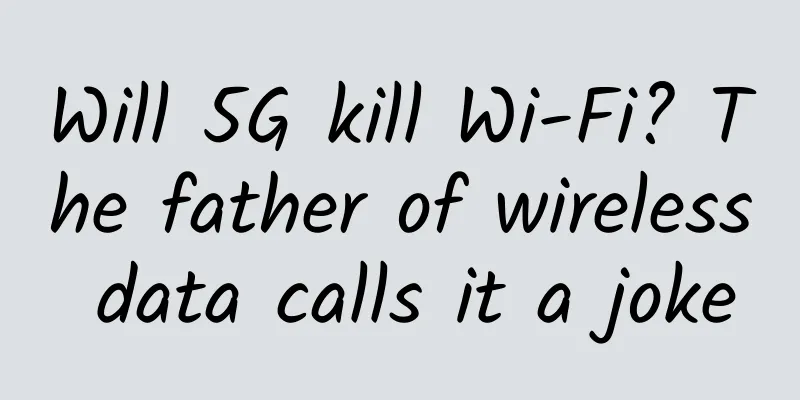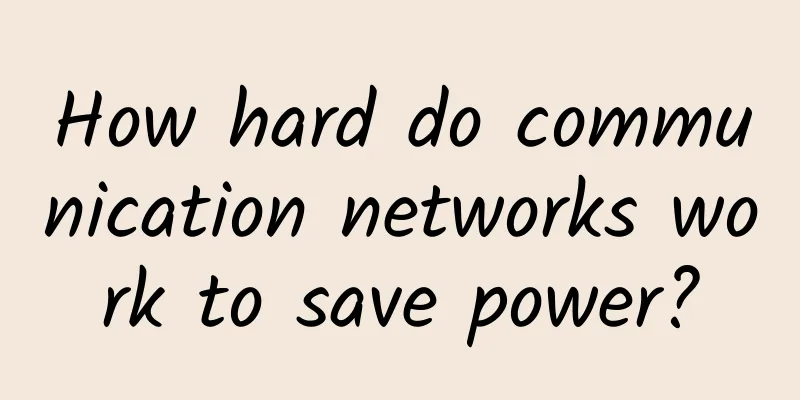Will 5G kill Wi-Fi? The father of wireless data calls it a joke

|
With the official release of 5G commercial photography, whether in the circle of friends or in the media, everyone has seen a lot of related content and has their own opinions on 5G. The power of 5G has led to some comments: in the future development, 5G will "eliminate" WiFi. Indeed, in the development over the years, from 2G to 3G, from 3G to 4G, and up to today's 5G, each generation of cellular mobile communication technology innovation has caused waves. On the contrary, WiFi, as one of the most widely used wireless network transmission technologies today, has received little attention every time it is updated. However, the news that "Shenzhen Futian Metro Station has applied WiFi6 technology" has brought the low-key technology of WiFi back into everyone's attention and brought a new term. We have just understood the concept of 5G, and now there is WiFi6. I believe many friends are confused, and some people have not even heard of it. So today I will talk to you about some related content about WiFi6, and I hope you can get to know and understand WiFi6. Before getting to know WiFi6, let us first take a brief look at what WiFi is and how WiFi developed. What is WiFi? WiFi is generally considered to be Wireless Fidelity. Simply put, it is a technology that can connect personal computers, handheld devices and other terminals to each other wirelessly. Nowadays, mobile terminals (laptops, tablets, smart phones, MP4) can basically receive WiFi signals. The full name of WiFi is wireless fidelity. In the field of wireless local area network, it refers to "wireless compatibility certification". It is essentially a commercial certification and also a wireless networking technology. In the past, computers were connected through network cables, but now they are connected through radio waves; the most common one is a wireless router. WiFi technology has a history of 20 years, from the first generation 802.11b to 802.11g, 802.11a, 802.11n, to the current 802.11ax (WiFi6). What is WiFi6? The latest generation of WiFi6, in technical terms, is 802.11AX. In early October last year, the Wi-Fi specification was renamed, and the new standard 802.11ax was renamed Wi-Fi 6. At the same time, the names of previous generations of WiFi were also changed accordingly:
In simple terms, the WiFi names used to be complicated and cumbersome, but now they are easy to understand. The biggest impact on us consumers is that in the future, when we buy a router, we only need to know that the larger the number after the WiFi, the more advanced the technology. It is understood that the latest generation of WiFi6 (802.11ax) can reach a transmission rate of up to 9.6Gbps, which means that the theoretical transmission speed reaches 1.2GB/s. With the arrival of WiFi6, it will cover more diverse applications, such as the Internet of Things, automobiles, and 4K video transmission. So what are the specific strengths of WiFi6? What impact will it have on the popular 5G? As consumers, what impact will WiFi6 have on our lives? What is the strength of Wi-Fi 6?
The impact of WiFi 6 on 5G What we can see now is that 5G will be the basis of 4k and 8k videos in the future, and 5G does have great potential. Even some industry insiders have said that when 5G comes, WiFi may be out of the market. However, WiFi 6, which is beginning to emerge, gives people a momentum to keep pace with 5G. First of all, we need to know that the application scenario modes of 5G and Wi-Fi are different. The former is a wide area network technology and is more used in outdoor scenarios, while Wi-Fi is mainly used in indoor environments. If 5G completely replaces Wi-Fi, then operators must launch truly unlimited data packages to make up for the network data needs of various hardware such as computers, tablets, smart homes, etc. in home and work scenarios, otherwise the costs will far exceed the current broadband costs. Cees Links, the father of wireless data, pointed out that WiFi applications in life account for 70% of the total, which is twice the data and scale of 5G. If these connections need to be achieved through 5G, operators need to build large base stations and invest huge costs. WiFi will not be replaced by 5G. Fast network speed is the first impression that 5G gives to consumers, but in fact, Wi-Fi 6 is faster. The peak rate of a single stream of Wi-Fi 6 can reach 1.2Gbps, while the peak rate of 5G network is 1Gbps. Therefore, throughout the 5G era, the network speed of Wi-Fi 6 may continue to be slightly higher than that of 5G network. Of course, the peak speed of WiFi6 needs to be based on the current broadband bandwidth. At the same time, flexible networking and network coverage are also a big problem. A major feature of 5G network is that it uses ultra-high frequency spectrum, which is 24Ghz to 52Ghz, but the higher the frequency, the weaker the ability to pass through obstacles, so 5G signals are easy to weaken to some extent. WiFi6 can be brought into basements and every corner of buildings through routers and wired networks. Compared with 5G networks, WiFi6 has stronger network coverage and stronger anti-interference ability. Therefore, although WiFi 6 is not a so-called impact on 5G, at least its position is preserved. I believe that in the future, WiFi 6 and 5G will most likely help each other, complement each other, and even merge with each other. The impact of WiFi 6 on life: the impact of smart home As a short-distance transmission standard, WiFi can reduce the burden on communication operators' base stations on the one hand. On the other hand, as the wireless connection center of smart homes, WiFi is unlikely to be replaced in the foreseeable future. Smart homes rely on WiFi and the Internet of Things for connectivity and communication. To achieve a truly connected smart home, WiFi6 allows all devices to communicate with wireless routers in multiple channels. And with the Pod in Every Room architecture, there is no need to use Zigbee and Bluetooth mesh, which extends battery life, simplifies setup and troubleshooting, and reduces user costs. In addition, pods provide more channels and can easily and smoothly connect IoT devices. Higher connectivity can be extended to the Internet of Things through sensors, devices, and audio assistance to create smart homes. To put it simply, the latest generation of WiFi6 technology may bring an innovation to indoor wireless networks, completely change the way the Internet of Things and smart homes are implemented, and further realize the smart life we have long imagined. |
<<: 6 places that provide free certificates to upgrade your website to HTTPS for free
>>: A simple understanding of the TCP/IP model, starting with the Hello World example
Recommend
How AI and software are driving 5G data center transformation
Today, we are witnessing a huge period of innovat...
Global fiber shortage threatens 5G and data center infrastructure
According to a report by the Financial Times (FT....
F5: Five trends in enterprise AI applications in Asia Pacific by 2025
Over the past year, I have had the privilege of s...
The world's first Android-enabled smart network tester is launched, and NETSCOUT shares the innovation story behind it
[51CTO.com original article] The most tense and e...
8 essential skills for network engineers in 2017
The current average job responsibilities of a net...
Analysis of API Gateway Selection of Several Major Cloud Vendors
1. What is an API Gateway? An API Gateway is a wa...
Insurance Geek: Lay a solid foundation and take group insurance to the extreme
[51CTO.com original article] As a worker, have &q...
How to cultivate talents needed for ecological collaboration? Huawei's talent ecosystem indicates that AI talents are the key training targets
[51CTO.com original article] On March 22, Huawei ...
It is said that WiFi will disappear after 5G becomes popular. Is this really the case?
5G is good, 5G is wonderful, and 5G will be great...
HostYun Los Angeles CN2 GIA line AMD series VPS simple test
We have shared information about VPS hosts in var...
Unlimited speed & 2TB large capacity! Alibaba Teambition cloud disk experience
[[355404]] The news that Alibaba is going to ente...
Huawei's Children's Day gift: from "one piece of chalk, one lesson" to VR participatory teaching
In order to improve the quality of basic educatio...
To promote industrial upgrading, Ascend Academy Technology Open Day came to Shenzhen
On August 11, 2020, the DevRun Developer Salon As...
InMotion Hosting Acquires RamNode
LEB released this news on March 4: InMotion Hosti...
Fast, intelligent, and secure cloud application delivery is the new trend in 2017! F5 invites you to start a more free cross-cloud journey
[51CTO.com original article] Cloud computing has ...









